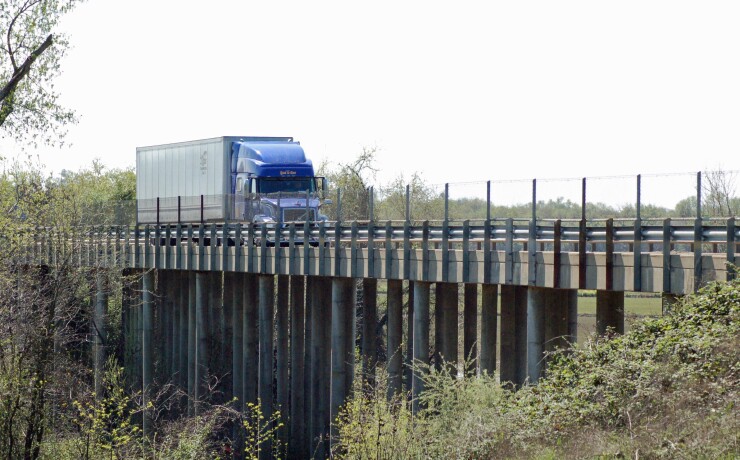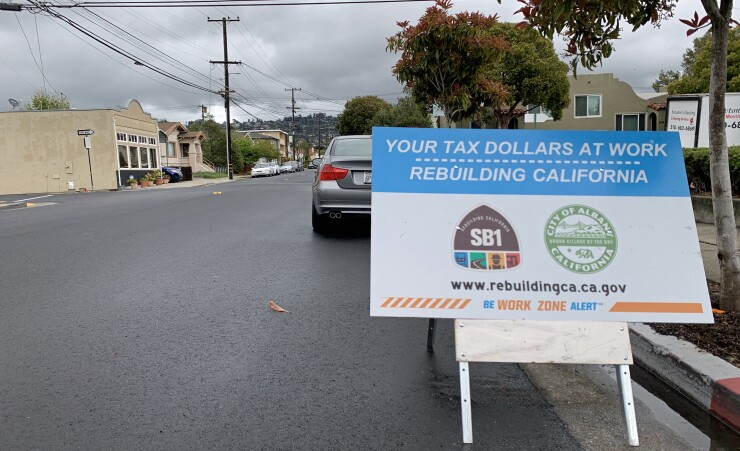Four years after California launched a massive 10-year transportation upgrade program that was billed as a game-changer for the state’s infrastructure, questions linger about whether the program is living up to its promise.
The Road Repair and Accountability Act of 2017, also known as SB 1, is expected to generate $54 billion by 2027 primarily through a gas tax increase.
The measure was enacted after a long

It included a 12-cent-per-gallon increase in the gasoline excise tax and a 20-cent-per-gallon diesel excise tax with annual increases for both linked to inflation, as well as new vehicle taxes and fees. California now has the highest gas tax in the nation, according to the Tax Foundation.
The revenues generate roughly $5 billion annually, which is divided equally between state and local agencies. The “fix it first” measure is aimed at upgrades of existing roads, culverts, bridges and transportation management systems, instead of new projects. The legislation does not include any bonding authority though the funds are used for projects that also rely on borrowing.
SB 1 is an effort to address California’s massive transportation backlog, which state transportation officials recently estimated at nearly $117 billion over the next 10 years. Other estimates put it as high as $130 billion.
That price tag goes beyond the needs identified in SB 1 and includes factors like sea level rise impacts, according to a May 2021 State Highway System Management Draft Plan. When all the state's needs are taken into account, SB 1 addresses about 45%, the report says.
State transportation officials say SB 1 is meeting all its targets and doing what it was intended to do.
“Over the last four plus years now that SB 1 has been the law of the land it’s helped to close that [infrastructure funding] gap, helped reduce risks to the system, and maintain and repair the roads sooner to avoid costlier repair in the future,” said California Department of Transportation spokesperson William Arnold.
As June 30, 2021, SB 1 has spent more than $15.5 billion on transportation across the state. That includes $8.8 billion for state and local transportation projects, $4 billion directly to cities and counties and $2.7 billion to transit agencies.
Through June 30, 2020, SB 1 has generated $11.1 billion, Arnold says.
The state has yet to calculate revenue through 2021 fiscal year end, or release the impact of COVID-19 on the gas tax. A December 2020 California Transportation Commission report projected that state gas tax revenues through the end of fiscal 202 would be down $1.9 billion from pre-COVID forecasts.
Critics say the program has failed to live up to its promises due to diversion of funds, regulatory hurdles and high labor costs.
“SB 1 was sold to California voters with a promise that the taxes collected would be used to fix highways, roads and bridges but that promise hasn’t been kept,” said Assemblymember Vince Fong, Kern County, who is vice chair of the Assembly’s Committee on Transportation.
Fong maintains that 23% of SB 1 funding has been diverted to non-road projects like bike lanes and that the program, which was not designed to add capacity, is failing to address road capacity to relieve congestion, a chief constituent complaint.
"The other aspect of SB 1 was the need to streamline the regulatory process to get more infrastructure done but projects have slowed down," Fong said.
The American Society of Civil Engineers in its most recent California Infrastructure Report Card rated the state's overall infrastructure with a grade of C-minus. Roads earned a D grade and bridges got a C-minus.
In contrast with in-state political pushback that was centered on the gas-tax increase that fuels SB 1, ASCE says California should be spending even more.
In the report, the ASCE praised SB 1 as the type of sustained revenue stream to support aging infrastructure systems but warns that it falls short of the more than $130 billion that ASCE estimates California needs “to bring the system back to a state of good repair.”

The ASCE also notes that US News & World Report Ranking puts California’s road conditions at 49th among the states.
Reason Foundation also found that California’s roads rank among the lowest in the nation, said Baruch Feigenbaum, its senior managing director of transportation policy.
The foundation’s
“We think we would have seen some indication that California roadways would have gotten better, but those roads are still in really bad shape,” and the state remains in the bottom 10 of all states, he said. “SB 1 was sold as a way to increase the quality of the pavement and thus far we haven’t seen any indication that’s happening.”
California was also in Reason’s bottom 10 for percent of rural interstates and urban interstates in poor condition and peak hours spent in auto congestion per commuter. On the bright side, the state ranked 24th among states for the percent of structurally deficit bridges, with 7.04%.
High labor costs are part of the problem as is the fact that some local governments began to redirect money that had gone to roads to other purposes after SB 1 became law, Feigenbaum said.
The state points to the increase in the percentage of highways in good condition, a key measure of the program, to illustrate its success.
In 2017, when SB 1 was adopted, roughly 41% of all state highways were considered in good condition as measured by Caltrans. That number has climbed to 57% as of June 30, 2021, according to the state. SB 1’s target is to have at least 98% of state highway pavement in good or fair condition by 2027.
Caltrans' State Highways Management System is expected to release its final report in a few weeks. The
“While the needs identified relative to pavement, bridges, culverts and transportation management systems are decreasing due to enhanced SB 1 investment level, the expanded range of needs identified in this plan means that available funding will address about 47% of total needs,” the report says. “The available funding is adequate to meet SB 1 targets for the primary assets. However, available funding is not adequate to meet all of the broader identified needs, requiring constraint in some objectives.”
To help address the non-SB 1 needs and manage the diminishing gas tax, California is hoping to develop alternative revenues from programs like mileage-based user fees.
Fong said the state should move away from the user-pay philosophy and put more non-gas tax generated revenue into transportation by tapping the general fund, budget surplus and one-time federal stimulus dollars.
“Unfortunately, there’s an affordability crisis in our state and SB 1 has only intensified it," Fong said.





